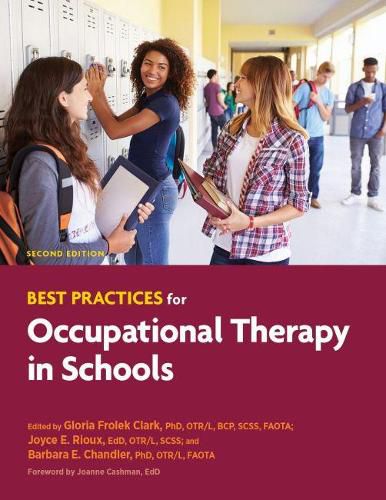Readings Newsletter
Become a Readings Member to make your shopping experience even easier.
Sign in or sign up for free!
You’re not far away from qualifying for FREE standard shipping within Australia
You’ve qualified for FREE standard shipping within Australia
The cart is loading…






Nearly 20% of occupational therapy practitioners work in school settings, requiring current, effective, and evidence-based best practices for students. Reflecting the extensiveness of occupational therapy practice in schools, the second edition of this bestseller contains best practices from preschool to postsecondary transitions, from ADLs to driving.
The latest edition of Best Practices for Occupational Therapy in Schools promotes best school practices, education, research, and policy and provides school occupational therapy practitioners with current, effective information to use in their daily practices. This comprehensive text details working with multiple student populations, transition planning, assistive technology, enhancing student participation, and work readiness. Appendixes provide resources for educators using the text in the classroom, documentation, assessment tools, liability issues, and templates for the occupational profile and occupational therapy intervention plan.
Highlights:
Section I. Foundations of Occupational Therapy in Schools. History, OTPF, laws, ethics, preparing students to practice, fieldwork, occupational therapy assistants, administrators. Section II. Evidence-Guided Practices: System-Level Considerations to Support Participation. Leadership and advocacy, supporting student access, family engagement, collaboration, resolving conflicts, determining workload, evaluation, Medicaid cost recovery, literacy and STEM skills, health and wellness, mental health, UDL, AT, transportation, transition planning. Section III. Evidence-Guided Practices: Population-Level Considerations to Support Participation. MTSSs, 504 plans, ADHD, autism, childhood trauma, emotional disturbance, hearing impairments or deafness, intellectual disability, low-incidence disabilities, physical disabilities, specific learning disabilities, TBI, visual impairment. Section IV. Evidence-Guided Practices: Service-Level Considerations to Support Participation. Evaluation and planning, intervention, group intervention, telehealth, nonpublic schools and homeschooling, documentation and data collection. Section V. Evidence-Guided Practices: Supporting Occupations to Enhance Student Participation. ADLs, mealtimes, IADLs, handwriting, reading, play and leisure, driver’s education, enhancing social participation. Section VI. Evidence-Guided Practices: Addressing Performance Skills to Enhance Student Participation. Executive function, fine motor skills, motor skills, sensory processing, visual perception and visual-motor skills. Appendixes. Future of school occupational therapy, assessments tools, evidence-based practice, liability insurance, guidelines for early intervention, occupational profile template, intervention plan, documentation, incorporating the text into a curriculum.
With a focus on student participation, Best Practices for Occupational Therapy in Schools, 2nd Edition, provides practical applications of evidence-based research to daily practice.
$9.00 standard shipping within Australia
FREE standard shipping within Australia for orders over $100.00
Express & International shipping calculated at checkout
Nearly 20% of occupational therapy practitioners work in school settings, requiring current, effective, and evidence-based best practices for students. Reflecting the extensiveness of occupational therapy practice in schools, the second edition of this bestseller contains best practices from preschool to postsecondary transitions, from ADLs to driving.
The latest edition of Best Practices for Occupational Therapy in Schools promotes best school practices, education, research, and policy and provides school occupational therapy practitioners with current, effective information to use in their daily practices. This comprehensive text details working with multiple student populations, transition planning, assistive technology, enhancing student participation, and work readiness. Appendixes provide resources for educators using the text in the classroom, documentation, assessment tools, liability issues, and templates for the occupational profile and occupational therapy intervention plan.
Highlights:
Section I. Foundations of Occupational Therapy in Schools. History, OTPF, laws, ethics, preparing students to practice, fieldwork, occupational therapy assistants, administrators. Section II. Evidence-Guided Practices: System-Level Considerations to Support Participation. Leadership and advocacy, supporting student access, family engagement, collaboration, resolving conflicts, determining workload, evaluation, Medicaid cost recovery, literacy and STEM skills, health and wellness, mental health, UDL, AT, transportation, transition planning. Section III. Evidence-Guided Practices: Population-Level Considerations to Support Participation. MTSSs, 504 plans, ADHD, autism, childhood trauma, emotional disturbance, hearing impairments or deafness, intellectual disability, low-incidence disabilities, physical disabilities, specific learning disabilities, TBI, visual impairment. Section IV. Evidence-Guided Practices: Service-Level Considerations to Support Participation. Evaluation and planning, intervention, group intervention, telehealth, nonpublic schools and homeschooling, documentation and data collection. Section V. Evidence-Guided Practices: Supporting Occupations to Enhance Student Participation. ADLs, mealtimes, IADLs, handwriting, reading, play and leisure, driver’s education, enhancing social participation. Section VI. Evidence-Guided Practices: Addressing Performance Skills to Enhance Student Participation. Executive function, fine motor skills, motor skills, sensory processing, visual perception and visual-motor skills. Appendixes. Future of school occupational therapy, assessments tools, evidence-based practice, liability insurance, guidelines for early intervention, occupational profile template, intervention plan, documentation, incorporating the text into a curriculum.
With a focus on student participation, Best Practices for Occupational Therapy in Schools, 2nd Edition, provides practical applications of evidence-based research to daily practice.